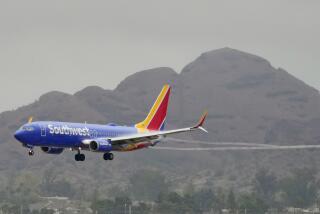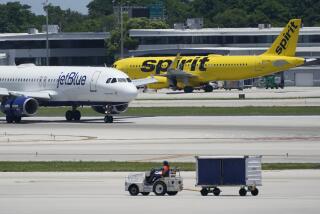JetBlue CEO sees benefit in big-airline mergers
JetBlue Airways Corp. is the kind of well-run niche airline that is supposed to get wiped out by the deal-making frenzy involving large network carriers such as United Airlines and Continental Airlines Inc.
Instead, JetBlue Chief Executive Dave Barger, 52, is on the prowl for opportunities to expand his low-cost carrier amid the market tumult.
Barger thinks JetBlue will gain customers because of the service lapses that tend to accompany colossal airline mergers. After all, the 10-year-old airline just survived one of the worst decades in aviation history by connecting with travelers through its friendly workers, brand-new planes and perks such as free satellite television, greater leg room and unlimited snacks.
“If the industry ends up with, say, three network carriers (from today’s five), there’s going to be plenty of space for the JetBlues of the world,” Barger in an interview at his company’s cramped offices at O’Hare International Airport in Chicago.
While larger competitors are tabling growth plans, Barger is strategizing on how to extend JetBlue’s reach throughout the Americas, even contemplating ordering next-generation wide-body jets including the Boeing 787 Dreamliner to handler longer flights.
But the challenge he faces is illustrated at O’Hare, where the nation’s No. 7 carrier remains a minor player three years after it entered the Chicago market. As JetBlue’s Chicago following grows, Barger would like to add more cross-county flights to California and eventually branch into tourist destinations in Florida and the Caribbean.
“We’re a pretty rare bird,” Barger said. “There are only a couple of airlines that flew into a second decade as a stand-alone brand.”
Yet the next 10 years could be as tough for Barger to navigate as the post-millennial era’s terrorist attacks, oil spikes and recessions. The consolidation underway makes the topsy-turvy airline market almost impossible to read.
To gain customers, JetBlue must differentiate itself from other carriers, analysts said. Trouble is, its quirky offerings and friendly service don’t seem as startlingly unconventional as they did when the carrier was launched in 2000.
JetBlue’s prices are frequently on par with those of network carriers. Virgin America, a California-based copycat launched in 2007, offers newer planes and hipper amenities: groovy mood lighting and touch-screen ordering off a menu offering marinated duck salads, mojitos and other nontraditional airline fare.
“From an operations, revenue-management and pricing perspective, [JetBlue] starts to look just like any other legacy airline,” aviation consultant Robert Mann said. “The question is, how long can you maintain a unique selling proposition if you’re not really that unique?”
Then there’s the task of expanding as the largest U.S. airlines are amassing clout and resources on an unprecedented scale. It’s not just mergers. Delta Air Lines Inc., AMR Corp.’s American Airlines and UAL Corp.’s United all have antitrust immunity to set prices with overseas alliance partners on transatlantic flights, and they’re pursuing similar joint ventures across the Pacific.
Some predict the new aviation superpowers will try to squash competitive threats such as JetBlue, even if they have to price flights below their costs to do so.
“There is economic opportunity for these carriers [in theory], but in the real world it isn’t going to happen,” Hubert Horan, an airline consultant and former Northwest Airlines executive, said of JetBlue.
Barger has been in this position before. He was part of the team that positioned JetBlue a decade ago as David to the industry’s Goliaths, including United, which benefited from sky-high prices even as it suffered the infamous summer of 2000 operations meltdown.
With its discounted fares, new jets, a home base at New York’s John F. Kennedy International Airport and a vow to “bring humanity back to flying,” JetBlue quickly became a consumer and media darling.
While most major U.S. carriers landed in Bankruptcy Court, JetBlue soared. David Neeleman, the carrier’s founder and first CEO, inspired laudatory books about the airline such as “Flying High.” Barger was the guy who made the carrier’s unconventional strategy work.
A decade later, JetBlue is the rare U.S. airline start-up to survive to maturity, even though Neeleman is gone, a casualty of JetBlue’s weeklong operations snafu that followed a Valentine’s Day snowstorm in 2007.
Barger is a throwback, a U.S. airline CEO who has been immersed in aviation his entire life. The son of a United Airlines pilot, Barger has never held a job outside the airline industry. For fun during his childhood, he’d spend entire days pacing Detroit Metro Airport, watching planes come and go and pondering how carriers matched aircraft to routes and frequencies.
After Neeleman left to found a start-up in Brazil, Barger dialed back JetBlue’s growth to survive sky-high fuel costs in 2008 and a global recession in 2009. He deferred airplane deliveries, sold a 17% stake to Germany’s Lufthansa and began distributing tickets through Sabre, a reservations system that gives the airline better access to business travelers.
His next task is to better distinguish JetBlue from its jumbo-size competitors.
The United-Continental tie-up plan comes after the 2008 merger of Delta and Northwest Airlines Corp., and some observers think it is inevitable that American Airlines and US Airways Group Inc. will be pressured into deals of their own. Rep. James L. Oberstar (D-Minn.), a vocal critic of large-scale mergers, warned in a May 5 letter to the Justice Department that U.S. airlines are headed for a market bereft of competition, where airfares will only rise.
“Making these carriers bigger and bigger definitely will make it more difficult for them to offer personalized service. Therefore, there’s room for the little guys,” countered Aaron Gellman, a professor at Northwestern University’s Transportation Center.
Leaving the consolidation to others, Barger said he intends to focus on organic growth.
“There’s no compelling need for them to merge with anyone,” added Henry Harteveldt, travel industry analyst at Forrester Research Inc.
But competing against the likes of a stronger Delta or merged United-Continental will be no picnic. In fact, JetBlue has struggled to make headway on its O’Hare-Kennedy flights, battling American, Delta, United and Southwest Airlines Co.
“We’re offering something like three out of 75 flights a day between Chicago and New York,” Barger said.
To attract corporate customers, JetBlue needs to offer a greater number of daily flights to large business centers. Creating a larger network would also help, although that would entail adding more aircraft and entering new cities at a time when expansion makes Wall Street nervous.
“History is not on their side,” said Vaughn Cordle, a financial analyst and former commercial airline pilot. “If they grow too fast, they destroy their value.”
Barger plans to add 10 new planes to JetBlue’s fleet this year and nine in 2011. Through 2018, the low-cost carrier is slated to take delivery of 113 aircraft, boosting its fleet 70%. Analysts expect Barger to defer orders, as he’s done in recent years, if JetBlue becomes at risk of being stuck with half-empty planes.
Barger is trying to win the loyalty of road warriors, even though JetBlue can’t offer them free tickets to exotic locales in Europe or Asia. Although other carriers black out free travel around major holidays, JetBlue sets no restrictions on the seats it awards TrueBlue members. Barger also is considering offering frequent fliers free Wi-Fi when JetBlue rolls out its onboard broadband in coming months.
The megadeals also give JetBlue an opportunity to pick up airport gates or landing rights divested by merging carriers. Harteveldt predicts the carrier will eventually form a Midwestern hub, maybe in markets including Cleveland, Memphis, Tenn., or Cincinnati affected by recent mergers.
For now, JetBlue is talking with the city of Chicago about expanding at O’Hare, although it doesn’t have immediate plans to add gates.
“We look forward to our continued partnership with JetBlue as it expands and grows its operations in Chicago,” said Karen Pride, a spokeswoman for the city’s Department of Aviation.
Barger would eventually like to fly from Chicago to tourist destinations in Florida, Mexico and the Caribbean. Places including Orlando, Fort Lauderdale, Tampa and Sarasota in Florida and San Juan, Puerto Rico, are on his wish list.
But Barger said he wouldn’t expand hastily and preferred “measured” growth.
“I like the idea of coming into JetBlue today to make it a little bit better tomorrow,” he said, “and never getting arrogant while we do it.”
More to Read
Inside the business of entertainment
The Wide Shot brings you news, analysis and insights on everything from streaming wars to production — and what it all means for the future.
You may occasionally receive promotional content from the Los Angeles Times.










